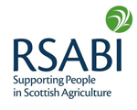James and Kath Traquair currently farm at Culnaha which is situated near Nigg, Tain. They have dealt with Watson Seeds for around 18 years, with most of their farming journey at Geiselittle in Thurso. They are predominantly a beef and sheep enterprise with their arable land leased to neighbours for cereals and potatoes. Culnaha farm was previously an intensive cereal growing enterprise. This has left challenges with boundary fencing, stock handling facilities, sheds and the most important aspect, soil health. This is where James began and in his first spring there, Watsons carried out a full soil analysis of his fields. The evaluation gave James information on any deficiencies in the soil. After rectifying these deficiencies, the crops have thrived and he is starting to build fertility back into his fields.
They have Lleyn/Lleyn cross breeding ewes and Hereford/Aberdeen Angus cross breeding cattle and are aiming to increase numbers going forward so the right grass mixture is a must. James has been delighted with the performance of Mingary giving him a persistent grazing platform, but also the ability to produce clover rich, quality silage. Key to the establishment of the pictured field in 2022 was a silage cut which cleaned up all the annual weeds before it was grazed with ewes and lambs. In 2023 the field was grazed before being shut up for a cut of silage in the middle of June, producing 231 bales from 38 acres, with the aftermath left for grazing lambs.
The silage was analysed and came back with an impressive analysis:
DM – 50%, D Value – 70.1%, Protein – 14.9%, ME – 11.2, PH – 5.1

"When walking the field in June 2023 what struck me most was the sheer amount of clover present and how good the grasses looked from having the grazing pressure of lambing ewes on it before being shut off for silage. Overall Mingary has done extremely well at Culnaha Farm, and we look forward to using it in future re seeds.” James Traquair.
Maris Kestrel kale and Triumph swede was sown to graze finishing lambs earlier in the winter. It has proven to be a great success with a steady stream of lambs been drawn out each week, destined for the Woodhead, Turriff. A mix was chosen over straight kale, as it gives James security if one brassica crop doesn’t do well, then the other brassica crop will then take over in its place, filling the void. To feed his in-lamb ewes and young stock over the winter James has grown swedes for the first time and he is delighted how they have performed on his light soils. Most will be grazed in situ, but some will be lifted to feed cattle inside.

Pictured is Euan in a field of Lomond swedes.
Growing fodder beet is also a first for James but they are ideally suited to his light soils. The aim is for the fodder beet to carry his ewes and possibly his replacement ewe lambs right though into April. Geronimo was the chosen variety after much deliberation because of its DM% (medium) and with just 55% of the root in the ground. All the fertiliser planning and spraying was advised by a local agronomist and carried out by the neighbouring farm.

Pictured is Euan in a field of Geronimo fodder beet.
The swedes and fodder beet were sown on the flat by local contractor Stuart Wilson, Fearn (who also sowed the Mingary seed). Stuart used his fodder beet drill to sow both the fodder beet and swedes with row spacing of 45cm. A crop yield measurement was taken in the second week of December. The findings are as follows - Lomond swedes 8.7 tonnes DM/ha and Geronimo fodder beet 26.9 tonnes DM/ha.
It is worth noting that both crops, especially the swedes, were grown on an extremely light, sandy soil. James is very happy with how the forage crops have done so far and is now putting pen to paper to see how much it has cost to produce per tonne/DM.
The swedes and fodder beet both have a huge runback and will be strip grazed accordingly using electric fencing.
The forage crops help James bridge a feed deficit over the winter in a cost effective manner. With the potential to produce high dry matters yields bought in feeds can be kept to a minimum. He is also aware of the boost he gets from resting his other grass leys. The brassicas provide a good break whilst also improving soil structure and, importantly, putting fertility back in. James is happy with the changes that he has already made at Culnaha and sees grass reseeding and forage crops as vital aspects of moving the farm forward in making it more productive, sustainable and profitable.




